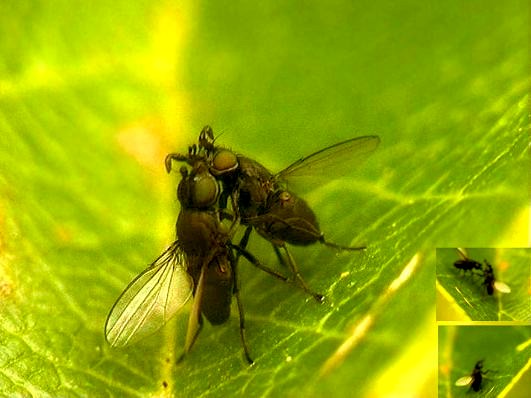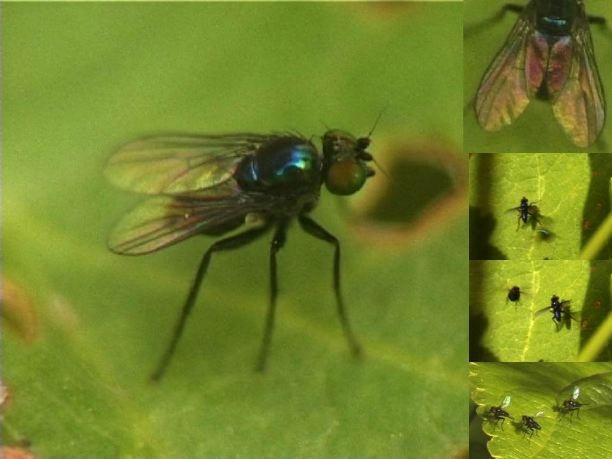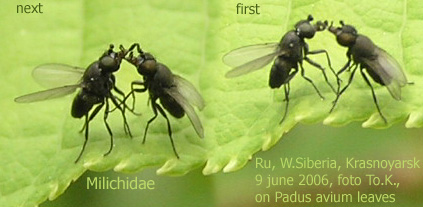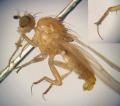Diptera.info :: Identification queries :: Diptera (eggs, larvae, pupae)
|
a strange weapon used in combat by an unidentyfied brachyceran sp.
|
|
| mwkozlowski |
Posted on 17-10-2006 22:21
|
|
Member Location: Warsaw, Poland Posts: 796 Joined: 17.10.06 |
This was on apple tree leaves in June. Males engeged on in combat throwing on each other their proboscis To learnrn more about this tactic one shoud know what flies they were. No idea!!! I submit a still frame from my camera filming footage. They were small flies some 2- 3 mm long.
mwkozlowski attached the following image:  [44.83Kb] Edited by mwkozlowski on 18-10-2006 09:29 |
|
|
|
| Nikita Vikhrev |
Posted on 18-10-2006 11:41
|
|
Member Location: Moscow, Russia Posts: 9500 Joined: 24.05.05 |
Well, what do we have? Acalyptrate fly with C break near R1. It seems that Sc reduced. In reality, flies are black (as on small images). I think that most probable candidate is Milichiidae. Nikita Nikita Vikhrev - Zool Museum of Moscow University |
|
|
|
| Paul Beuk |
Posted on 18-10-2006 12:32
|
|
Super Administrator Location: Netherlands Posts: 19403 Joined: 11.05.04 |
And the long proboscis would make Phyllomyza a likely candidate.
Paul - - - - Paul Beuk on https://diptera.info |
| Tony Irwin |
Posted on 18-10-2006 15:49
|
|
Member Location: Norwich, England Posts: 7320 Joined: 19.11.04 |
Are we sure these are two males? I wonder whether these may be a male and female getting carried away in some pre-nuptial behaviour. Does each fly have a long proboscis, or does one fly have two very long palps? Why do some Phyllomyza males have very long palps, if not for this sort of fun? 
Tony ---------- Tony Irwin |
|
|
|
| Nikita Vikhrev |
Posted on 18-10-2006 15:57
|
|
Member Location: Moscow, Russia Posts: 9500 Joined: 24.05.05 |
Cherchez la femme!!!
Nikita Vikhrev - Zool Museum of Moscow University |
|
|
|
| Tony Irwin |
Posted on 18-10-2006 22:23
|
|
Member Location: Norwich, England Posts: 7320 Joined: 19.11.04 |
Looking at this photo on a better screen, I think I favour the equally-matched proboscis-fighting explanation, though I suspect they are actually Desmometopa. I suppose that any small fly that spends its time stealing from spiders is likely to be a bit prone to physical confrontation - stress and so on.  In any case it's a remarkable picture.  Is there any way we can get to download the film? - it would be wonderful to see the action! Is there any way we can get to download the film? - it would be wonderful to see the action!
Tony ---------- Tony Irwin |
|
|
|
| Paul Beuk |
Posted on 19-10-2006 07:24
|
|
Super Administrator Location: Netherlands Posts: 19403 Joined: 11.05.04 |
Considering the number of Desmometopa specimens that can be found on a single 'host', feeding together, I doubt that stress will be the cause of a physical confrontation iike this. If I remember I will dig up my copy of Sabrosky's paper on Desmometope (you could be right there) and see if he mentions anything.
Paul - - - - Paul Beuk on https://diptera.info |
| mwkozlowski |
Posted on 19-10-2006 10:37
|
|
Member Location: Warsaw, Poland Posts: 796 Joined: 17.10.06 |
Females!!! Even more interresting. That was a funny day. I was engaged in "nice shots" (flowers, ants so on) for commertial TV and it was sunny day but little windy, so leaves moved. I had no time to concentrate much on flies, but on young apple tres around the were two fly shows! On suny leaves there were jumping dolichoforid (?) flies. They were engaged in some ritual competition jumping alternately till one left. (see the picture, what species again????) at the same time on the same trees but on more shady leaves I noticed these grey flies wrestlinfg. They were rather fast and the leaves moved, so I could not make any valuable filming just this stop frame
mwkozlowski attached the following image:  [57.49Kb] |
|
|
|
| ToK |
Posted on 02-04-2007 15:51
|
|
Member Location: Posts: 2 Joined: 31.03.07 |
F:/Milichidae_behavior_Krasnoyrsk.jpg |
|
|
|
| crex |
Posted on 02-04-2007 16:33
|
|
Member Location: Sweden Posts: 1996 Joined: 22.05.06 |
ToK wrote: F:/Milichidae_behavior_Krasnoyrsk.jpg Hi! The link would have worked if you had put the file on a server accessible by all via HTTP (i.e. not just your own hard disk drive) ... or you could use the attach function (beware the file limitations, naming conventions etc). |
|
|
|
| komarik |
Posted on 18-01-2008 14:34
|
|
Member Location: RUS, Moscow reg. Posts: 23 Joined: 05.01.08 |
RU, Siberia, Krasnoyarsk, early summer (spring in terms of Moscow Region). On leaves of Padus avium.
komarik attached the following image:  [43.31Kb] |
|
|
|
| Igor Grichanov |
Posted on 19-01-2008 08:45
|
|
Member Location: St.Petersburg, Russia Posts: 1789 Joined: 17.08.06 |
Posted on 19-10-2006 11:37 are Chrysotus sp. (Dolichopodidae)
Igor Grichanov |
| mwkozlowski |
Posted on 25-02-2008 18:24
|
|
Member Location: Warsaw, Poland Posts: 796 Joined: 17.10.06 |
Igor, do you this are there the same spp. no my and Komarik pictures. Time about the same, his on cherry leaves, my on apple leaves?
very general entomologist |
|
|
|
| Ectemnius |
Posted on 18-02-2020 09:47
|
|
Member Location: The Netherlands Posts: 865 Joined: 22.11.11 |
Hello mwkozlowski & komarik, Both your photo's show the species Desmometopa microps. New for the fauna of Poland and Russia. Also new is the spectacular behaviour observed and photographed. This has not been reported in any other species of Desmometopa to date. Could I use your photo's in a publication I am writing together with Irina Brake? Kind regards, Ectemnius |
|
|
|
| Jump to Forum: |













